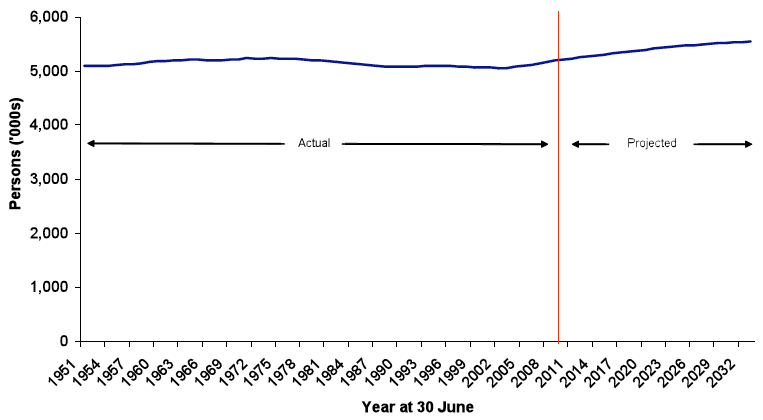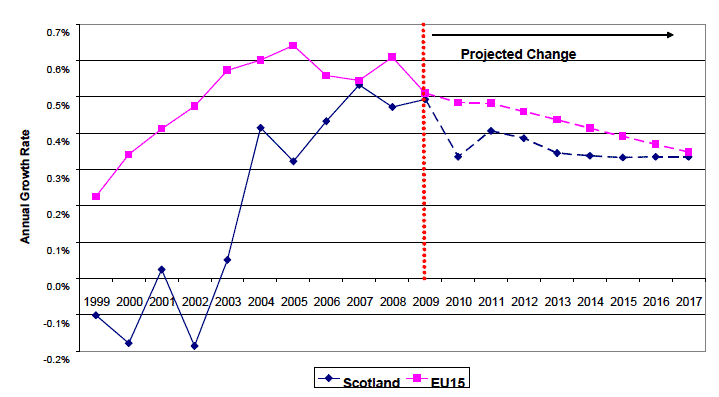Demographic Change in Scotland
This research paper sets out current evidence relating to demogrpahy in Scotland, exploring the implications of demographic change and related policy issues, with reference to Scotland's Population Growth Purpose Target
2. POPULATION GROWTH
- Scotland's population has grown in recent years, now standing at 5,194,000.
- Increases in net in-migration and fertility, as well as increased life expectancy, have all contributed to recent population growth.
Population growth
2.1 In contrast to the situation which gave rise to the Scottish Demography Research Programme, Scotland's population is now growing. After many years of decline, Scotland's population has increased in each of the last 7 years, with particularly strong growth over the period 2005-06 to 2008-09. The 2009 GROS mid year estimates put the population of Scotland at 5,194,000, a 25,500 increase on the previous year. In the 10 years to 2009 the population grew by 2.4%, increasing by 122,000 from 5.07 million. Current GROS projections (principal projection, 2008 based), which project changes based on the continuation of recent trends in the drivers of population growth, show the population rising to 5.54 million by 2033 (see Figure 1).
Figure 1: Estimated population of Scotland, actual and projected, 1951 - 2033

Source: GROS (2009)
2.2 Trends in both natural change and migration are now contributing to the overall picture of population increase. GROS figures for recent years have shown several years of net in-migration, an increase in Scotland's fertility rate, and continued improvements in mortality and life expectancy (although this has not been matched by the same level of increase in healthy life expectancy). In relation to migration, the numbers of those coming to Scotland have exceeded those leaving Scotland for each of the last 7 years; in 2008-9, 22,000 more people arrived in Scotland than left. The initial years in the current period of population growth were driven by migration, but natural change has also been a factor in more recent years. Births have exceeded deaths each year since 2006-7 resulting in positive natural change, with the number of births exceeding the number of deaths by around 4,585 in 2008-9. This figure is driven by an upturn in the number of births, combined with a reduction in the number of deaths each year, with life expectancy increasing for both men and women. This positive rate of natural change is projected to continue until around 2027 ( GROS 2008 based projections). Although positive natural change has contributed to population growth since 2006-7, migration is still the biggest contributing factor, accounting for over 80% of the population increase from 2007-8 to 2008-9.
2.3 In a country as diverse as Scotland, there is always interest in geographic variation, and in particular in urban/rural distinctions. While there has been a 2.4% increase in the population overall between 1999 and 2009, this has not been uniform across the country. GROS 2009 mid year estimates shows that 20 local authorities gained population over the period, while 12 authorities lost population, with figures ranging from net population loss of 6% in Inverclyde to a population gain of 10.5% in West Lothian. Both urban and rural authorities feature in the list of losers and gainers, with 9 of Scotland's 14 rural authorities increasing their populations, and 5 experiencing population decreases 5.
2.4 The recent growth in Scotland's population appears to be a positive scenario, with increases in fertility, life expectancy and in-migration all playing their part. However, it is still important to understand the detail of current trends and the factors influencing them - and the geographical variation within them - in order to inform policy decisions that will support continued population growth and progress towards the population target and allow Scotland to respond effectively to the demands of the changes in its demographic structure (including in relation to its ageing population).
Progress towards the Population Growth Purpose Target
2.5 Scotland's population target was introduced in recognition of the part that population growth (and population profile) plays in economic growth. The target is relative, with the aim of matching population growth in the EU15 countries 6 over a 10 year period. The annual growth rate recorded for Scotland in 2008-9 of 0.49% showed an increase on previous years and closed the gap with other EU countries, but was still below the overall 0.51% growth recorded for the EU15. The relative nature of the target is important in understanding Scotland's progress towards it. Table 2 shows that over the first 2 years of the target period the EU15 population has grown by a total of 1.12 per cent, whilst the Scottish population increased by 0.97 per cent over the same period. For Scotland to have matched EU15 growth over this period, the Scottish population would have had to increase by around 57,800 - an additional 8,000 people compared to the estimated growth over the period. This 8,000 can be seen as the current deficit on the target, which, as the target is cumulative over the 10 year period 2007 to 2017, will have to be addressed over the remaining 8 years. The majority of this gap is due to Scotland's lower population growth rate in 2007-08.
Table 2: Performance against population growth target (source: GROS, and Eurostat)
EU15 Growth Rate |
Scotland Growth Rate |
Change in Scottish Population |
Change required to match EU15 |
Gap |
|
|---|---|---|---|---|---|
2007-08 |
0.61 |
0.47 |
24,300 |
31,300 |
-7,000 |
2008-09 |
0.51 |
0.49 |
25,500 |
26,400 |
-900 |
Total |
1.12 |
0.97 |
49,800 |
57,800 |
-8,000 |
Note: Figures may not sum to total due to rounding
2.6 Although Scotland has achieved population growth in the 7 years prior to 2008-9 and has narrowed the gap with the EU15 countries, population growth has been a feature in many EU15 countries (in particular, Spain, France, Ireland, and the United Kingdom), and this has kept the overall EU15 growth rate relatively high, with projections indicating that this trend will continue (Eurostat 2008-based population projections).
2.7 It is, however, not clear how sustainable the recent observed population growth within Scotland will be. With the improved growth based to a large extent on net in-migration - and to a lesser extent on increased fertility (see para 2.2) - there are a number of factors which may have an impact in future years. In relation to migration these include the following:
- The economic downturn, and uncertainty over the nature of the recovery (i.e. in particular regarding the number of new job opportunities that will be created), may make Scotland a less attractive option for migrants.
- In relation to the EUA8 7 countries which joined the EU in 2004, Sweden, Ireland and the UK granted EUA8 citizens the right to live and work freely, while the other existing EU countries imposed initial restrictions, which must be lifted within 7 years of EU accession. Once these restrictions are lifted, Scotland will be competing with a wider range of countries in attracting EUA8 migrants. In addition, economic conditions are improving in many EUA8 countries making remaining at home more attractive for potential migrants.
- Changes to the UK Government's Points Based System for Managed Migration (including the introduction of an annual limit on non- EU immigration to the UK) may impact on the numbers of migrants coming to Scotland.
2.8 These factors may result in a downturn in the number of migrants coming to Scotland 8 (which may then have a knock on effect on the birth rate, given the contribution that migrants make in this area - see para 5.8). In addition, the long term settlement intentions of the current migrant population are uncertain and there may be increasing numbers who choose to return to their country of origin or move on to another country. Interestingly, though, the most recent GROS figures (2009 mid year estimates) show the net migration gain from overseas (17,500) returning to the previous peak level of 2006-7 (16,800) following a dip in 2007-8.
2.9 In relation to fertility, the birth rate can fluctuate as a result of social and economic factors, and the impact of the recent economic downturn is not yet known. Historically it can, though, be seen that earlier upturns in the birth rate in Scotland (eg, during the late 1970s) have subsequently fallen back to previous levels.
2.10 Using the latest EU15 population projections, produced by Eurostat and based on the 2008 population 9, it is possible to obtain a broad indication of the level of change required in Scotland's population in order to match EU15 growth over the period to 2017. This analysis estimates that average annual growth of around 23,000 to 24,000 in Scotland's population will be required to meet the population target. Figure 2 compares the latest estimates and projections of annual population growth in Scotland and the EU15. The projections are based on the central (principal) projection for Scotland and the EU15. The projections suggest that annual population growth in Scotland will continue to lag the EU15 over the period to 2017 - although there will be a convergence in annual rates by the end of the period. However, the projections are based on the population in 2008, and for the first year of the projection period (2009) underestimated the level of change in the population in both Scotland and the EU15 10. The projections suggest that the Scottish population will increase by 2.9% between 2009 and 2017, compared to 3.4% in the EU15 - this would lead to a shortfall of around 30,000 in the required level of growth to meet the target over this period.
Figure 2: Estimated and projected annual population growth rates for Scotland and EU15

Source: ONS, Eurostat
2.11 Although the main focus of the population target may be on population growth, the aim that this should be supported by increased healthy life expectancy is also important to note. Healthy life expectancy ( HLE) is a measure of years spent in good health 11. As well as recognising the inherent benefits to the well-being of the individual, the inclusion of this aspect of the population target recognises the additional contribution that a population that stays healthy and active for longer can make to economic growth and civic life in Scotland. HLE at birth has been gradually increasing in Scotland since 1980 and currently stands at 68.1 for men and 70.8 for women (Scottish Government, 2010 12), thus meeting the requirements of the population target. However, further analysis shows that the gap between life expectancy and healthy life expectancy has not closed, meaning that, while the number of years spent in good health has increased, the number of years spent in poor health in Scotland has not decreased (see para 4.6).
2.12 While this section has looked at population growth in Scotland, the following section looks at the age structure of the population, and Scotland's ageing population in particular. The relationship between population growth and economic growth is complicated by the age profile of the population (as well as the health of the population) as this impacts on employment rates, as well as influencing, for example, demand for age related goods and services (public and private).
There is a problem
Thanks for your feedback